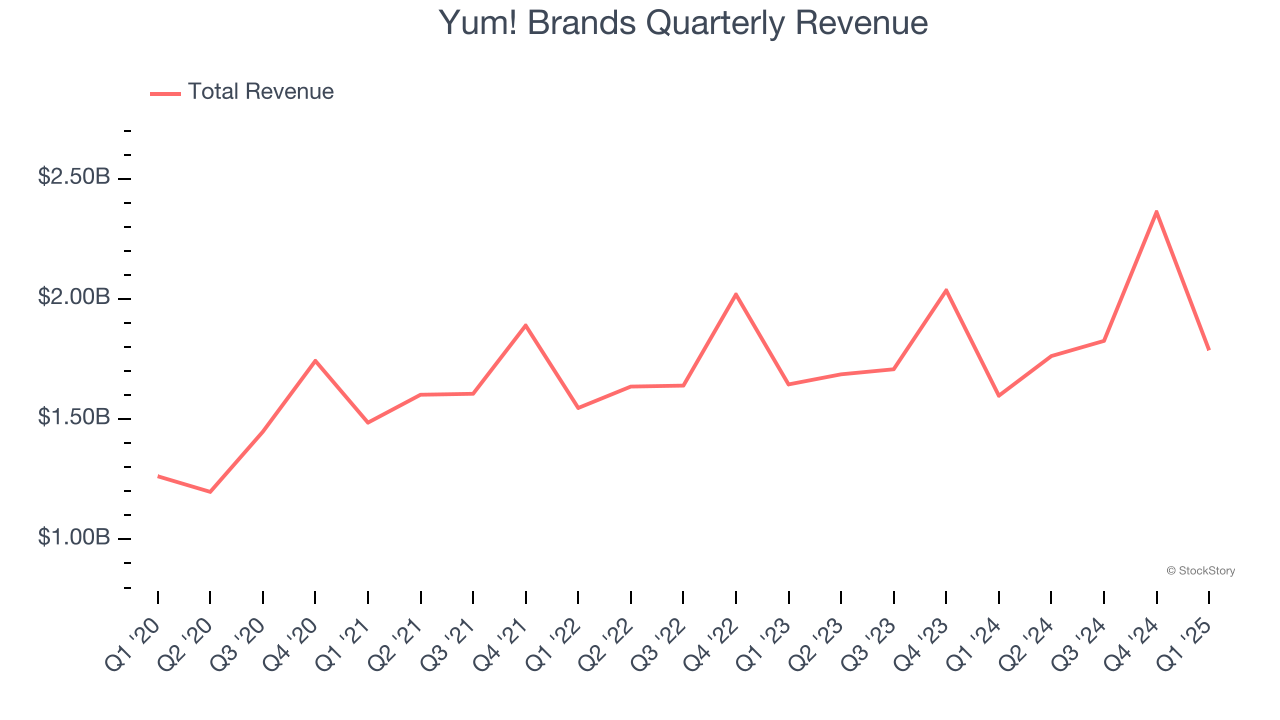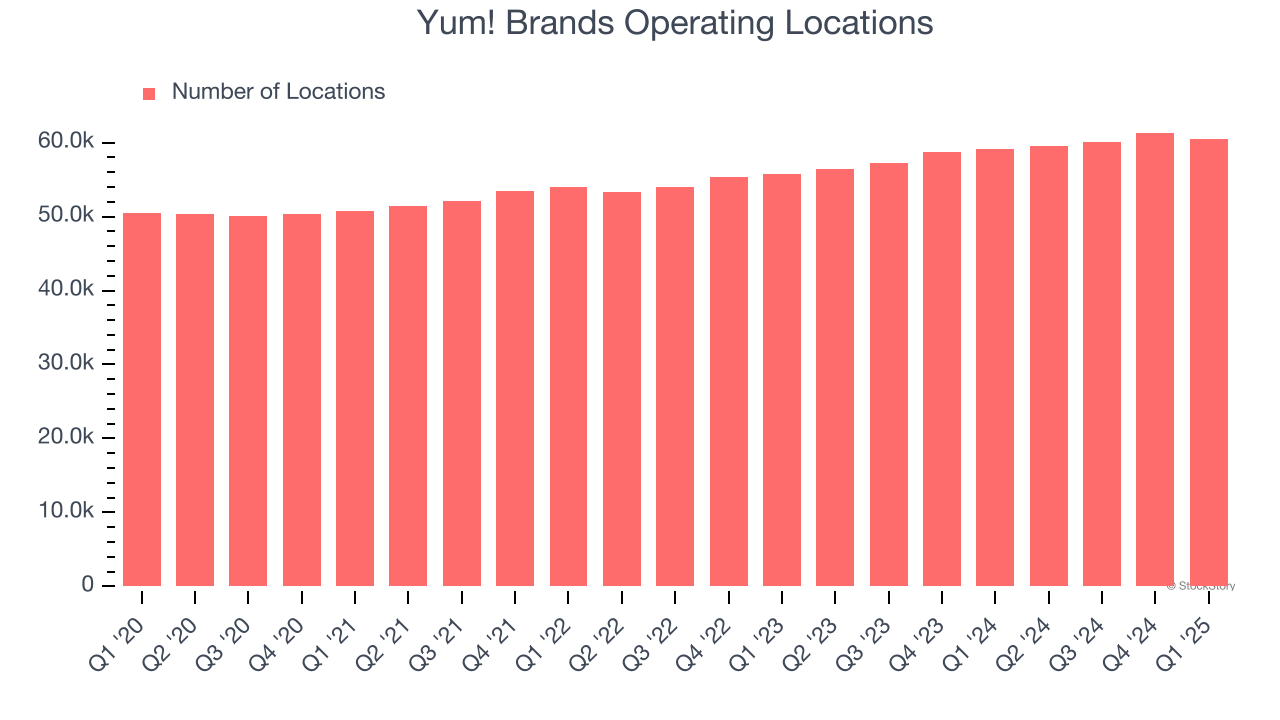
Fast-food company Yum! Brands (NYSE: YUM) fell short of the market’s revenue expectations in Q1 CY2025, but sales rose 11.8% year on year to $1.79 billion. Its non-GAAP profit of $1.30 per share was 1.4% above analysts’ consensus estimates.
Is now the time to buy Yum! Brands? Find out by accessing our full research report, it’s free.
Yum! Brands (YUM) Q1 CY2025 Highlights:
- Revenue: $1.79 billion vs analyst estimates of $1.85 billion (11.8% year-on-year growth, 3.2% miss)
- Adjusted EPS: $1.30 vs analyst estimates of $1.28 (1.4% beat)
- Maintained long-term growth algorithm
- Free Cash Flow Margin: 18.6%, down from 19.6% in the same quarter last year
- Locations: 60,507 at quarter end, up from 59,129 in the same quarter last year
- Same-Store Sales rose 3% year on year (-3% in the same quarter last year, slight beat vs expectations of +2.7%)
- Market Capitalization: $41.13 billion
Company Overview
Spun off as an independent company from PepsiCo, Yum! Brands (NYSE: YUM) is a multinational corporation that owns KFC, Pizza Hut, Taco Bell, and The Habit Burger Grill.
Sales Growth
A company’s long-term sales performance is one signal of its overall quality. Any business can experience short-term success, but top-performing ones enjoy sustained growth for years.
With $7.74 billion in revenue over the past 12 months, Yum! Brands is larger than most restaurant chains and benefits from economies of scale, enabling it to gain more leverage on its fixed costs than smaller competitors. Its size also gives it negotiating leverage with suppliers, allowing it to source its ingredients at a lower cost. However, its scale is a double-edged sword because there is only so much real estate to build restaurants, placing a ceiling on its growth. To expand meaningfully, Yum! Brands likely needs to tweak its prices, start new chains, or enter new markets.
As you can see below, Yum! Brands grew its sales at a tepid 5.6% compounded annual growth rate over the last six years (we compare to 2019 to normalize for COVID-19 impacts) as it barely increased sales at existing, established dining locations.

This quarter, Yum! Brands’s revenue grew by 11.8% year on year to $1.79 billion but fell short of Wall Street’s estimates.
Looking ahead, sell-side analysts expect revenue to grow 6.4% over the next 12 months, similar to its six-year rate. This projection is underwhelming and implies its newer menu offerings will not catalyze better top-line performance yet. At least the company is tracking well in other measures of financial health.
Today’s young investors won’t have read the timeless lessons in Gorilla Game: Picking Winners In High Technology because it was written more than 20 years ago when Microsoft and Apple were first establishing their supremacy. But if we apply the same principles, then enterprise software stocks leveraging their own generative AI capabilities may well be the Gorillas of the future. So, in that spirit, we are excited to present our Special Free Report on a profitable, fast-growing enterprise software stock that is already riding the automation wave and looking to catch the generative AI next.
Restaurant Performance
Number of Restaurants
Yum! Brands sported 60,507 locations in the latest quarter. Over the last two years, it has opened new restaurants at a rapid clip by averaging 5.1% annual growth, among the fastest in the restaurant sector. Furthermore, one dynamic making expansion more seamless is the company’s franchise model, where franchisees are primarily responsible for opening new restaurants while Yum! Brands provides support.
When a chain opens new restaurants, it usually means it’s investing for growth because there’s healthy demand for its meals and there are markets where its concepts have few or no locations.

Same-Store Sales
The change in a company's restaurant base only tells one side of the story. The other is the performance of its existing locations, which informs management teams whether they should expand or downsize their physical footprints. Same-store sales is an industry measure of whether revenue is growing at those existing restaurants and is driven by customer visits (often called traffic) and the average spending per customer (ticket).
Yum! Brands’s demand within its existing dining locations has been relatively stable over the last two years but was below most restaurant chains. On average, the company’s same-store sales have grown by 1.8% per year. This performance suggests it should consider improving its foot traffic and efficiency before expanding its restaurant base.

In the latest quarter, Yum! Brands’s same-store sales rose 3% year on year. This growth was an acceleration from its historical levels, which is always an encouraging sign.
Key Takeaways from Yum! Brands’s Q1 Results
It was good to see Yum! Brands slightly beat analysts’ same-store sales and EPS expectations this quarter. On the other hand, its revenue missed. Overall, this was a mixed quarter. The stock traded down 1.4% to $145.45 immediately following the results.
Yum! Brands didn’t show it’s best hand this quarter, but does that create an opportunity to buy the stock right now? When making that decision, it’s important to consider its valuation, business qualities, as well as what has happened in the latest quarter. We cover that in our actionable full research report which you can read here, it’s free.







